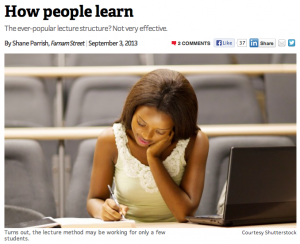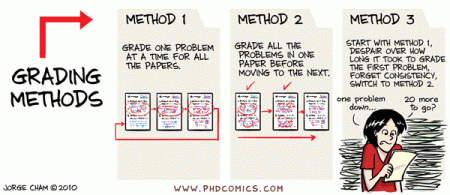The following entry from the 2012-2013 Teaching Issues Writing Consortium: Teaching Tips was contributed by Ken Sagendorf, Ph.D Director, Center for Excellence in Teaching and Learning (CETL), Regis University.
————————————————————————————————————–
Inclusive learning environments are promoted by finding out about your students and responding to what you learn. It is this responsiveness to your students that moves a course design from teacher-centered to learning-focused.
It is often easy to sit in your office by yourself and think about the courses you will teach. Maybe you prefer the coffee shop on the corner or at home late at night like me. Each time we design a lecture or a lesson or an entire course in this manner, it becomes easy to omit the most important factor in the teaching and learning environment – the student as the learner. And working by ourselves allows us to gloss over the assumptions we are making about those in the audience meant to be the beneficiaries of our plans. If these assumptions go unacknowledged and the students are not part of the consideration in designing instruction, it makes it difficult to design learning-focused lessons or courses. It is easy to think about these assumptions but how often do you take the time to write them out?
Use the quick fill-ins below to identify the student learning factors that should be addressed in your lessons or courses and to remind you what assumptions you are making about your students.
From that perspective that the absolutely perfect students enroll in your class, what characteristics (as learners) would you want those students to have to run your ideal lesson or course and see those wonderful students succeed? Take a moment to think about the background knowledge, skills, and attitudes you would like your students to have upon entering your lesson or course. Write those thoughts down below.
Ideal World Answers
Coming into your lesson/course…
What background knowledge do students will NEED to possess to succeed in your course?
What kind of learning skills do students will NEED to possess to succeed in your course? Consider the vast array of skills such as reading skills; writing abilities; study skills; test-taking abilities; thinking skills; organizational skills; mathematical skills; laboratory skills; library skills; etc.)
What kind of attitude do students will NEED to possess to succeed in your course? (i.e., expectations, interests, motivation to work and meet the demands of your course, willingness to revise completed work, etc.)
Next, consider talking with faculty that may have taught your lesson or course before. Talk with students that have taken similar courses or even your course in previous offerings. Ask them about that knowledge, those skills, and those attitudes that they actually had when they were about to enter your lesson or course. Ask them to be honest – brutally so. Use those answers to help you respond as best you can to the questions below.
Real World Answers
Coming into your lesson/course …
RW-A: What background knowledge do you think students will actually possess upon entering your course?
RW-B: What learning skills do you think students will actually possess upon entering your course?
RW-C: What attitudes do you think students will actually possess upon entering your course?
Now, compare the answers you have written. Usually there are some mismatches. After all, we all don’t usually teach our ideal students. We teach our real students. The mismatches or gaps between these sets of answers are the student learning factors that will limit the potential learning for your students in your lesson or course.
Gaps in Students’ Knowledge: The gap(s) between the background knowledge I want students to know coming into my course and the students I will actually have is/are:
Gaps in Students’ Skills: The gap(s) between the learning skills I want students to know coming into my course and the students I will actually have is/are:
Gaps in Students’ Attitudes: The gap(s) between the attitudes I want students to know coming into my course and the students I will actually have is/are:
In order for student learning to be optimized in your lesson or course, these gaps will need to be intentionally addressed in the lessons or in homework of the course.
And now that some of your assumptions about your students are written down, use them to ask your students questions once they actually become part of your course. Consider knowledge probes or skill-trying-out lessons early on in the semester. The approach of faculty mentioned in the Ken Bain book What the Best College Teachers Do of try, fail, receive feedback, and try again works wonderfully to find out what skills your students have or need work on. Finally, and most importantly, respond to what you find out by adapting your lessons and course to the actual students in your course. This ability to respond to what you find out will go a long way toward making your students feel included in the learning process and will allow you to meet your high expectations for them.
Ken Sagendorf, Ph.D.
Director, Center for Excellence in Teaching and Learning (CETL)
Regis University
ksagendorf@regis.edu
 The article “How People Learn” from The Week explores Carl Wieman’s ideas about how to improve learning. Wieman, a Nobel laureate in Physics and advocate for research based teaching practice, makes the case for a number of changes to enhance learning.
The article “How People Learn” from The Week explores Carl Wieman’s ideas about how to improve learning. Wieman, a Nobel laureate in Physics and advocate for research based teaching practice, makes the case for a number of changes to enhance learning.

